#Example of Utility Software
Explore tagged Tumblr posts
Text
AI’s productivity theater
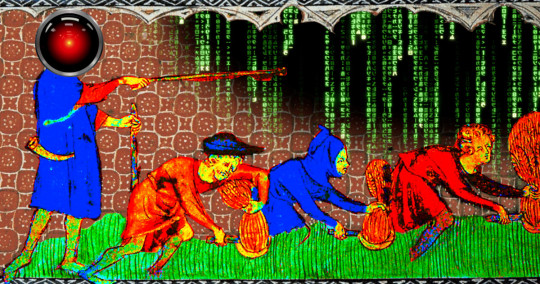
Support me this summer on the Clarion Write-A-Thon and help raise money for the Clarion Science Fiction and Fantasy Writers' Workshop!

When I took my kid to New Zealand with me on a book-tour, I was delighted to learn that grocery stores had special aisles where all the kids'-eye-level candy had been removed, to minimize nagging. What a great idea!
Related: countries around the world limit advertising to children, for two reasons:
1) Kids may not be stupid, but they are inexperienced, and that makes them gullible; and
2) Kids don't have money of their own, so their path to getting the stuff they see in ads is nagging their parents, which creates a natural constituency to support limits on kids' advertising (nagged parents).
There's something especially annoying about ads targeted at getting credulous people to coerce or torment other people on behalf of the advertiser. For example, AI companies spent millions targeting your boss in an effort to convince them that you can be replaced with a chatbot that absolutely, positively cannot do your job.
Your boss has no idea what your job entails, and is (not so) secretly convinced that you're a featherbedding parasite who only shows up for work because you fear the breadline, and not because your job is a) challenging, or b) rewarding:
https://pluralistic.net/2024/04/19/make-them-afraid/#fear-is-their-mind-killer
That makes them prime marks for chatbot-peddling AI pitchmen. Your boss would love to fire you and replace you with a chatbot. Chatbots don't unionize, they don't backtalk about stupid orders, and they don't experience any inconvenient moral injury when ordered to enshittify the product:
https://pluralistic.net/2023/11/25/moral-injury/#enshittification
Bosses are Bizarro-world Marxists. Like Marxists, your boss's worldview is organized around the principle that every dollar you take home in wages is a dollar that isn't available for executive bonuses, stock buybacks or dividends. That's why you boss is insatiably horny for firing you and replacing you with software. Software is cheaper, and it doesn't advocate for higher wages.
That makes your boss such an easy mark for AI pitchmen, which explains the vast gap between the valuation of AI companies and the utility of AI to the customers that buy those companies' products. As an investor, buying shares in AI might represent a bet the usefulness of AI – but for many of those investors, backing an AI company is actually a bet on your boss's credulity and contempt for you and your job.
But bosses' resemblance to toddlers doesn't end with their credulity. A toddler's path to getting that eye-height candy-bar goes through their exhausted parents. Your boss's path to realizing the productivity gains promised by an AI salesman runs through you.
A new research report from the Upwork Research Institute offers a look into the bizarre situation unfolding in workplaces where bosses have been conned into buying AI and now face the challenge of getting it to work as advertised:
https://www.upwork.com/research/ai-enhanced-work-models
The headline findings tell the whole story:
96% of bosses expect that AI will make their workers more productive;
85% of companies are either requiring or strongly encouraging workers to use AI;
49% of workers have no idea how AI is supposed to increase their productivity;
77% of workers say using AI decreases their productivity.
Working at an AI-equipped workplaces is like being the parent of a furious toddler who has bought a million Sea Monkey farms off the back page of a comic book, and is now destroying your life with demands that you figure out how to get the brine shrimp he ordered from a notorious Holocaust denier to wear little crowns like they do in the ad:
https://www.splcenter.org/fighting-hate/intelligence-report/2004/hitler-and-sea-monkeys
Bosses spend a lot of time thinking about your productivity. The "productivity paradox" shows a rapid, persistent decline in American worker productivity, starting in the 1970s and continuing to this day:
https://en.wikipedia.org/wiki/Productivity_paradox
The "paradox" refers to the growth of IT, which is sold as a productivity-increasing miracle. There are many theories to explain this paradox. One especially good theory came from the late David Graeber (rest in power), in his 2012 essay, "Of Flying Cars and the Declining Rate of Profit":
https://thebaffler.com/salvos/of-flying-cars-and-the-declining-rate-of-profit
Graeber proposes that the growth of IT was part of a wider shift in research approaches. Research was once dominated by weirdos (e.g. Jack Parsons, Oppenheimer, etc) who operated with relatively little red tape. The rise of IT coincides with the rise of "managerialism," the McKinseyoid drive to monitor, quantify and – above all – discipline the workforce. IT made it easier to generate these records, which also made it normal to expect these records.
Before long, every employee – including the "creatives" whose ideas were credited with the productivity gains of the American century until the 70s – was spending a huge amount of time (sometimes the majority of their working days) filling in forms, documenting their work, and generally producing a legible account of their day's work. All this data gave rise to a ballooning class of managers, who colonized every kind of institution – not just corporations, but also universities and government agencies, which were structured to resemble corporations (down to referring to voters or students as "customers").
Even if you think all that record-keeping might be useful, there's no denying that the more time you spend documenting your work, the less time you have to do your work. The solution to this was inevitably more IT, sold as a way to make the record-keeping easier. But adding IT to a bureaucracy is like adding lanes to a highway: the easier it is to demand fine-grained record-keeping, the more record-keeping will be demanded of you.
But that's not all that IT did for the workplace. There are a couple areas in which IT absolutely increased the profitability of the companies that invested in it.
First, IT allowed corporations to outsource production to low-waged countries in the global south, usually places with worse labor protection, weaker environmental laws, and easily bribed regulators. It's really hard to produce things in factories thousands of miles away, or to oversee remote workers in another country. But IT makes it possible to annihilate distance, time zone gaps, and language barriers. Corporations that figured out how to use IT to fire workers at home and exploit workers and despoil the environment in distant lands thrived. Executives who oversaw these projects rose through the ranks. For example, Tim Cook became the CEO of Apple thanks to his successes in moving production out of the USA and into China.
https://archive.is/M17qq
Outsourcing provided a sugar high that compensated for declining productivity…for a while. But eventually, all the gains to be had from outsourcing were realized, and companies needed a new source of cheap gains. That's where "bossware" came in: the automation of workforce monitoring and discipline. Bossware made it possible to monitor workers at the finest-grained levels, measuring everything from keystrokes to eyeball movements.
What's more, the declining power of the American worker – a nice bonus of the project to fire huge numbers of workers and ship their jobs overseas, which made the remainder terrified of losing their jobs and thus willing to eat a rasher of shit and ask for seconds – meant that bossware could be used to tie wages to metrics. It's not just gig workers who don't score consistent five star ratings from app users whose pay gets docked – it's also creative workers whose Youtube and Tiktok wages are cut for violating rules that they aren't allowed to know, because that might help them break the rules without being detected and punished:
https://pluralistic.net/2024/01/13/solidarity-forever/#tech-unions
Bossware dominates workplaces from public schools to hospitals, restaurants to call centers, and extends to your home and car, if you're working from home (AKA "living at work") or driving for Uber or Amazon:
https://pluralistic.net/2020/10/02/chickenized-by-arise/#arise
In providing a pretense for stealing wages, IT can increase profits, even as it reduces productivity:
https://pluralistic.net/2024/01/11/robots-stole-my-jerb/#computer-says-no
One way to think about how this works is through the automation-theory metaphor of a "centaur" and a "reverse centaur." In automation circles, a "centaur" is someone who is assisted by an automation tool – for example, when your boss uses AI to monitor your eyeballs in order to find excuses to steal your wages, they are a centaur, a human head atop a machine body that does all the hard work, far in excess of any human's capacity.
A "reverse centaur" is a worker who acts as an assistant to an automation system. The worker who is ridden by an AI that monitors their eyeballs, bathroom breaks, and keystrokes is a reverse centaur, being used (and eventually, used up) by a machine to perform the tasks that the machine can't perform unassisted:
https://pluralistic.net/2023/04/12/algorithmic-wage-discrimination/#fishers-of-men
But there's only so much work you can squeeze out of a human in this fashion before they are ruined for the job. Amazon's internal research reveals that the company has calculated that it ruins workers so quickly that it is in danger of using up every able-bodied worker in America:
https://www.vox.com/recode/23170900/leaked-amazon-memo-warehouses-hiring-shortage
Which explains the other major findings from the Upwork study:
81% of bosses have increased the demands they make on their workers over the past year; and
71% of workers are "burned out."
Bosses' answer to "AI making workers feel burned out" is the same as "IT-driven form-filling makes workers unproductive" – do more of the same, but go harder. Cisco has a new product that tries to detect when workers are about to snap after absorbing abuse from furious customers and then gives them a "Zen" moment in which they are showed a "soothing" photo of their family:
https://finance.yahoo.com/news/ai-bringing-zen-first-horizons-192010166.html
This is just the latest in a series of increasingly sweaty and cruel "workplace wellness" technologies that spy on workers and try to help them "manage their stress," all of which have the (totally predictable) effect of increasing workplace stress:
https://pluralistic.net/2024/03/15/wellness-taylorism/#sick-of-spying
The only person who wouldn't predict that being closely monitored by an AI that snitches on you to your boss would increase your stress levels is your boss. Unfortunately for you, AI pitchmen know this, too, and they're more than happy to sell your boss the reverse-centaur automation tool that makes you want to die, and then sell your boss another automation tool that is supposed to restore your will to live.
The "productivity paradox" is being resolved before our eyes. American per-worker productivity fell because it was more profitable to ship American jobs to regulatory free-fire zones and exploit the resulting precarity to abuse the workers left onshore. Workers who resented this arrangement were condemned for having a shitty "work ethic" – even as the number of hours worked by the average US worker rose by 13% between 1976 and 2016:
https://pluralistic.net/2024/01/11/robots-stole-my-jerb/#computer-says-no
AI is just a successor gimmick at the terminal end of 40 years of increasing profits by taking them out of workers' hides rather than improving efficiency. That arrangement didn't come out of nowhere: it was a direct result of a Reagan-era theory of corporate power called "consumer welfare." Under the "consumer welfare" approach to antitrust, monopolies were encouraged, provided that they used their market power to lower wages and screw suppliers, while lowering costs to consumers.
"Consumer welfare" supposed that we could somehow separate our identities as "workers" from our identities as "shoppers" – that our stagnating wages and worsening conditions ceased mattering to us when we clocked out at 5PM (or, you know, 9PM) and bought a $0.99 Meal Deal at McDonald's whose low, low price was only possible because it was cooked by someone sleeping in their car and collecting food-stamps.
https://www.theguardian.com/us-news/article/2024/jul/20/disneyland-workers-anaheim-california-authorize-strike
But we're reaching the end of the road for consumer welfare. Sure, your toddler-boss can be tricked into buying AI and firing half of your co-workers and demanding that the remainder use AI to do their jobs. But if AI can't do their jobs (it can't), no amount of demanding that you figure out how to make the Sea Monkeys act like they did in the comic-book ad is doing to make that work.
As screwing workers and suppliers produces fewer and fewer gains, companies are increasingly turning on their customers. It's not just that you're getting worse service from chatbots or the humans who are reverse-centaured into their workflow. You're also paying more for that, as algorithmic surveillance pricing uses automation to gouge you on prices in realtime:
https://pluralistic.net/2024/07/24/gouging-the-all-seeing-eye/#i-spy
This is – in the memorable phrase of David Dayen and Lindsay Owens, the "age of recoupment," in which companies end their practice of splitting the gains from suppressing labor with their customers:
https://prospect.org/economy/2024-06-03-age-of-recoupment/
It's a bet that the tolerance for monopolies made these companies too big to fail, and that means they're too big to jail, so they can cheat their customers as well as their workers.
AI may be a bet that your boss can be suckered into buying a chatbot that can't do your job, but investors are souring on that bet. Goldman Sachs, who once trumpeted AI as a multi-trillion dollar sector with unlimited growth, is now publishing reports describing how companies who buy AI can't figure out what to do with it:
https://www.goldmansachs.com/intelligence/pages/gs-research/gen-ai-too-much-spend-too-little-benefit/report.pdf
Fine, investment banks are supposed to be a little conservative. But VCs? They're the ones with all the appetite for risk, right? Well, maybe so, but Sequoia Capital, a top-tier Silicon Valley VC, is also publicly questioning whether anyone will make AI investments pay off:
https://www.sequoiacap.com/article/ais-600b-question/
I can't tell you how great it was to take my kid down a grocery checkout aisle from which all the eye-level candy had been removed. Alas, I can't figure out how we keep the nation's executive toddlers from being dazzled by shiny AI pitches that leave us stuck with the consequences of their impulse purchases.

If you'd like an essay-formatted version of this post to read or share, here's a link to it on pluralistic.net, my surveillance-free, ad-free, tracker-free blog:
https://pluralistic.net/2024/07/25/accountability-sinks/#work-harder-not-smarter

Image: Cryteria (modified) https://commons.wikimedia.org/wiki/File:HAL9000.svg
CC BY 3.0 https://creativecommons.org/licenses/by/3.0/deed.en
#pluralistic#productivity theater#upwork#ai#labor#automation#productivity#potemkin productivity#work harder not smarter#scholarship#bossware#reverse centaurs#accountability sinks#bullshit jobs#age of recoupment
463 notes
·
View notes
Note
Hello!!! I hope you don't mind doing this one,
Can you help me write a traumatized person who's having trouble talking because of past trauma? (They can still interact with people, but only with signs and movements, not voice) and also a little anxious
Tell me if you need more details =)
How to Write a Mute / Non-Speaking Character
-> healthline.com
-> verywellhealth.com
-> descriptionary.wordpress.com
Types of Mutism:
selective mutism: having the ability to speak but feeling unable to.
organic mutism: mutism caused by brain injury, such as with drug use or after a stroke.
cerebellar mutism: mutism caused by the removal of a brain tumor from a part of the skull surrounding the cerebellum, which controls coordination and balance.
aphasia: when people find it difficult to speak because of stroke, brain tumor, or head injury.
What Causes Selective Mutism in Adults?
having another anxiety condition, like separation anxiety or social anxiety
experiencing physical, emotional, or sexual abuse
having a family history of selective mutism or social anxiety
having fewer opportunities for social contact
having an extremely shy personality
having a speech or language disorder, learning disability, or sensory processing disorder
parent-child enmeshment, or lack of clear boundaries in the relationship
traumatic experiences
Traumatic Mutism vs Trauma-Induced Selective Mutism
if you have traumatic mutism, you may be unable to talk in all situations following a trauma.
with trauma-induced selective mutism, you may find it impossible to talk only in certain situations-- for example, in front of the person who hurt you or in a setting that resembles the circumstances of your trauma.
Different Ways Individuals with Mutism May Choose to Communicate:
Nonverbal Communication: they may rely on facial expressions, gestures, eye contact, and body language to convey their thoughts, emotions, and intentions.
Writing or Typing: they may use a pen and paper, digital devices, or communication apps to write messages, notes, or responses.
Sign Language: they can convey meaning, emotions, and engage in complex conversations through hand signs, facial expressions, and body movements.
Augmentative and Alternative Communication (AAC) Devices: these devices provide individuals with a range of tools and technologies to support their communication needs. They can include speech-generating devices, picture boards, apps, or software that allows users to select words, phrases, or symbols to generate spoken or written output.
Communication Boards and Visual Aids: Communication boards or charts with pictures, symbols, or words can assist individuals in conveying their messages.
Assistive Technology: various assistive technologies, such as speech-to-text apps, text-to-speech programs, or eye-tracking devices that aid individuals with communication.
Tips on Writing a Mute / Non-Speaking Character:
Explore the vast array of nonverbal cues such as facial expressions, body language, gestures, and eye contact. Use descriptions to convey their intentions and reactions.
Utilize internal dialogue. Offer readers a window into their internal thought process, and turn their internal dialogue into a narrative that reveals their inner struggles, triumphs, and complexities so that reader can connect with the character.
Establish a communication system that is unique to your character (Sign language, written notes, telepathy in a fantasy setting, etc.). Having a communication system allows your character to interact with other characters and contribute to the narrative.
Surround them with Understanding Characters that can aid in communcation and fostering meaningful relationships.
Establish the Barriers/Conflicts They'll Experience. Don't forget to be realistic.
Your character is not defined by their inability to speak. Make sure you do not write stereotypes and cliches. Being mute is only one aspect of their identity rather than their defining trait.
Do your research! Seek out firsthand accounts, experiences, and perspectives. Check out online forums and resources to gain insights into their unique challenges, adaptations, and strengths.
If you like what I do and want to support me, please consider buying me a coffee! I also offer editing services and other writing advice on my Ko-fi! Become a member to receive exclusive content, early access, and prioritized writing prompt requests.
#writing prompts#creative writing#writeblr#how to write#writing tips#writing advice#writing resources#writing help#writing tools#how to write a mute character#how to write a non-speaking character#how to write characters
564 notes
·
View notes
Note
Hey, so I really love Lore Rekindled, and the art is one of my favorite parts! The style, the coloring, the background, all of it is just so… smooth! I don’t really know how to describe it. Recently, I’ve been trying to replicate it, and I was hoping you would give me a few pointers. What brushes do you use for line art? How do you decided what to line, and what to leave blank? What about coloring brushes? Do you use smudge brushes? Whats, like, the step by step process? You don’t have to answer if you don’t want to! But any tips or answers would be great!
Ah thanks so much!!!
Here are the brushes! They're .abr brushes, so they should work in Photoshop, Clip Studio and Procreate :) (they don't work in Krita or other software that utilizes PNG brushes though, sorry ; ; )
There's also a tutorial included with that file that breaks down my process layer by layer! That said, there are a couple things that have changed in my process since doing that tutorial:
I mostly use the Hard Square Pastel brush now for all of that 'crispy' lighting that often happens along the edges of characters' shoulders and heads, such as seen here:

I now do an extra step of applying a 'blur' layer, where I essentially merge all the layers into a new layer on top of everything, set it to Overlay, and then Gaussian Blur by about 60%. This is how I get that 'dreamy' look that's been present in a lot of the more recent episodes!
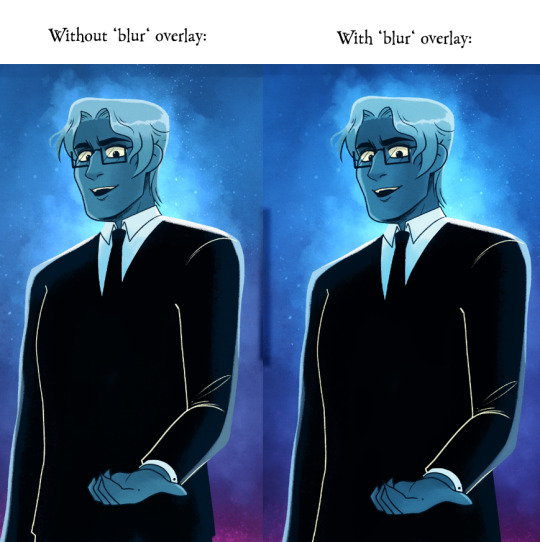
It's subtle, but really effective in making the glow effects and deeper colors really pop!
As for the more nuanced stuff like lineart, it's kinda just something I do by feel! Sometimes I'll shade something in and realize the lineart doesn't need to be there, so then I'll go in and erase, other times I have to be a bit more excessive with it esp if two similar colors are up against each other. I'm actually trying to use less lineart going forward to get more of that authentic LO look but it's hard, I'm very used to doing lineart-heavy drawings so it's forcing me to draw in a way that I'm not used to! 😆 I usually always start with flat colors first though, meaning I start by 'shaping' out the character poses and then lining them in afterwards!
You can see an example of this process in my END OF PERSEPHONE time lapse here:
youtube
I also usually stream work sessions of Rekindled over on my Twitch, but I'm currently on hiatus from streaming due to technical difficulties (OBS just... decided it was gonna stop working, sigh). Go give it a follow anyways tho so you can be notified when I start streaming again! I'm thinking in the meantime until I can get my Twitch going again I might start doing some screen sharing sessions in Discord. So keep your eyes peeled for that if you ever wanna catch me working! I'm always happy to talk about and demystify the process <3
95 notes
·
View notes
Text
Also preserved in our archive
"Just a cold" that changes the structure and mass of your brain
By Nikhil Prasad
Medical News: A groundbreaking study from researchers at the University of California, Los Angeles (UCLA)-USA has shed light on how Long COVID is linked to structural changes in the brain caused by SARS-CoV-2. By using advanced imaging techniques, the team discovered structural changes in the brains of individuals with Long COVID, including increased cortical thickness and gray matter volume in specific regions. This Medical News report will explore the study's key findings, its implications for understanding Long COVID, and what it means for patients suffering from this persistent condition.
Understanding the Research Approach The study involved participants from the UCLA hospital and broader Los Angeles community, with 36 individuals ranging in age from 20 to 67. Among them, 15 had Long COVID symptoms, while others were used as healthy controls. Researchers utilized structural magnetic resonance imaging (MRI) to compare brain differences between these groups. The study focused on specific brain regions, such as the dorsolateral prefrontal cortex (DLPFC) and the cingulate gyrus, which are known to be involved in cognitive and emotional processes. These areas were chosen because they are susceptible to inflammation and have been linked to neuropsychiatric symptoms.
To assess participants' cognitive and emotional health, tools like the Montreal Cognitive Assessment (MoCA) and the Hamilton Anxiety and Depression scales were used. The imaging data were processed using specialized software to measure cortical thickness and gray matter volume, providing a detailed look at the brain's structural changes.
Key Study Findings The study revealed several critical findings that deepen our understanding of Long COVID's impact on the brain. Participants with Long COVID showed:
-Increased Cortical Thickness: Regions such as the caudal anterior cingulate, posterior cingulate, and rostral middle frontal gyrus exhibited significantly higher cortical thickness compared to controls.
-Higher Gray Matter Volume: In areas like the posterior and isthmus cingulate gyri, Long COVID patients had greater gray matter volume.
Interestingly, these structural changes were associated with the severity of clinical symptoms. For example, higher thickness in the cingulate regions correlated with more severe chronic illness scores, while increased insular thickness was linked to anxiety levels.
Such changes suggest that Long COVID might lead to either swelling due to inflammation or compensatory mechanisms like neurogenesis to counteract damage.
How This Study Compares with Previous Research While most COVID-19-related brain studies have shown reductions in gray matter and cortical thickness, this research indicates an increase in these metrics for Long COVID pa tients. Prior studies focused on acute COVID cases often revealed brain shrinkage and cognitive decline. In contrast, this study highlights that Long COVID might involve unique mechanisms, such as prolonged inflammation or a compensatory response to earlier damage.
Implications for Patients and Healthcare Providers These findings are crucial for both patients and healthcare professionals. They suggest that the persistent symptoms of Long COVID, such as brain fog, fatigue, and anxiety, could have a physical basis in brain structure changes. Recognizing this connection can lead to better-targeted treatments and interventions.
The Future of Long COVID Research While this study offers valuable insights, it also leaves many questions unanswered. For example, are these brain changes reversible? Do they worsen over time? The researchers acknowledge the study's limitations, including its small sample size and lack of longitudinal data. Future studies should aim to include larger, more diverse populations and examine changes over time to build a clearer picture of Long COVID's effects.
Conclusions This research from UCLA represents a significant step forward in understanding the neurological impacts of Long COVID. The observed increases in cortical thickness and gray matter volume in certain brain regions provide strong evidence that Long COVID involves measurable structural brain changes. These findings offer hope that by identifying the physical manifestations of this condition, we can develop more effective treatments to alleviate its symptoms. However, the path forward requires continued research to uncover the full extent of these changes and their implications.
The study emphasizes the importance of addressing neuropsychiatric symptoms in Long COVID patients and highlights the need for comprehensive care that includes both physical and mental health support. As we move forward, it is vital to integrate these insights into public health strategies to help those affected by this debilitating condition.
The study findings were published in the peer-reviewed journal: Frontiers in Psychiatry. www.frontiersin.org/journals/psychiatry/articles/10.3389/fpsyt.2024.1412020/full
#mask up#public health#wear a mask#pandemic#wear a respirator#covid#covid 19#still coviding#coronavirus#sars cov 2#long covid#covid is not over
48 notes
·
View notes
Text
Twin Moon Knight Rellana has the best rendition of "boob-armour" I've seen in fiction:
Edit: Why'd Tumblr mark this as mature??
Why The Trope Is Usually Dumb and Bad:
In general, an effective suit of armour needs padding underneath to absorb blows, meaning it shouldn't fit so tightly around the chest as to require a built-in bra, and the common boob-armour divot used to define cleavage only serves to direct attacks directly into the chest. It's impractical to both make and wear. That COULD be used by a smart writer to say something about the character wearing it, but almost always it's just fan-service at the cost of the story's cohesion, with no deeper meaning.
Now let's look at Rellana's armour:
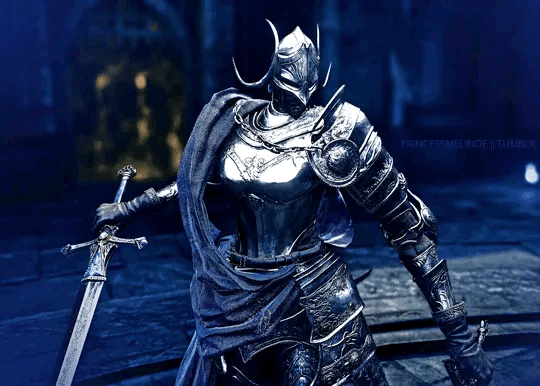
Why Rellana's Armour is Cool and Good:
Rellana's armour was carefully designed to avoid all the common pitfalls. First and foremost, there's no cleavage! Instead, they've taken a cinched-waist breastplate that normally utilizes an hourglass shape (example below), and added subtle definitions that get the point across without sacrificing protective capabilities. Sure, it's still more form-fitting than real armour, but that's standard for From Software's stylized armour designs.
Next, the armour directly aligns with the character and setting it's found in/on. Rellana isn't some standard soldier; she's ex-royalty, which opens up a rarely-accessed avenue of historical precedent. The ceremonial armour of nobility was RIFE with impractical designs made only to show off. Enormous codpieces, crazy skirts, breastplates with sculpted pecs and abs, etc. (also see below)
Now, it's still impractical to FIGHT in ceremonial armour, but Carian Nobility (and ER as a whole) already has a well-established tendency of doing so. Plus, it aligns directly with what we know of Rellana's character: she's a wizard-princess turned warrior that really wants to catch the attention/affection of Messmer. Thus she wears armour that declares her as Knight, Noble, and Woman.

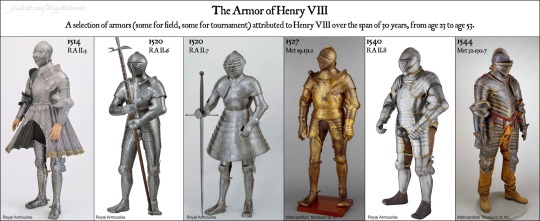
#also I love how you can see#king henry viii#gradually packing on the pounds with each suit of armour in that last pic#sad Elden Ring never got a skirt like he wore too#twin moon knight#elden ring#shadow of the erdtree#elden ring sote#elden ring rellana#rellana#rellana twin moon knight#armor design#armour design#fantasy worldbuilding#messmer the impaler#elden ring messmer#fromsoft#fromsoftware#from software
108 notes
·
View notes
Note
if you were making a syllabus for a comics class, besides the obvious (homestuck, hark a vagrant, a comic from KC green, a comic from ONE), what comics would you say best represent webcomics as a medium/ are needed to represent the medium? I always liked your hitmen for destiny rec and was wondering if you knew anything else like that
if we're talking about representations of the format rather than just examples of good comics, i think the choices would be really different. for one thing i would cut hark a vagrant and kc green comics since, while both good, they "operate" more or less the same as print comics and utilize the internet primarily as a means of distribution rather than incorporating it into the creation process (beyond making colors websafe, when applicable)
as a lowbrow example, jerkcity (or whatever its called now) is a purely web-based creation. the scripts are private chats dumped into microsoft comic chat and generated from pre-made software assets. im not a fan personally, but there are xkcd comics that make conscious use of the web-medium/infinite canvas to create comics that can literally only exist in a web format (homestuck is the same, but on a massive scale which would make it hard to teach in this scenario). bouletcorp (english website dead? huge loss imo) featured quite a few comics that took advantage of readers needing to scroll in order to obtain more information. e.m. carroll's horror works capitalized on the use of scroll and click to induce tension in the reader. dinosaur comics managing to squeeze decades of comedic juice out of clip art dinosaurs arranged in the same layout every day.
i feel like a class about webcomics should be about the comics that differentiate it from the print medium, if that makes sense. manhua would also fit into this but i would choose cutbu as the example bc i love cutbu comics lol. they came back last year just so everyone knows. with a comic called 28th century superfan
60 notes
·
View notes
Text
Watcher's Expenses
I didn't major in accounting: I took three classes and it grinded my brain to a fine powder. However, after graduating with a business admin degree, being a former eager fan of their videos, and from a cursory glance over their socials, there's a lot to consider in their spending behavior that really could start racking up costs. Some of these things we've already noticed, but there are other things I'd like to highlight, and I'll try to break it down into the different categories of accounting expenses (if I get something wrong, let me know. I was more concentrated in marketing 🤷���♀️). I'm not going to hypothesize numbers either, as that would take out more time than I'm willing to afford-- you can assume how much everything costs. Anyways, here's my attempt at being a layman forensic accountant:
Note: All of this is assuming they're operating above board and not engaging in any illegal practices such as money laundering, tax evasion, not paying rent, etc.
Operating Expenses
Payroll: 25+ staff salaries and insurance
Overhead Expenses
CEO/founder salaries
Office space leasing or rent (In L.A, one of the most expensive cities in the US)
Utilities (water, electricity, heating, sanitation, etc.)
Insurance
Advertising Costs
Telephone & Internet service
Cloud Storage or mainframe
Office equipment (furniture, computers, printers, etc.)
Office supplies (paper, pens, printer ink, etc.)
Marketing costs (Social media marketing on Instagram, Youtube, SEO for search engines, Twitter, etc. Designing merchandise and posters, art, etc. )
Human Resources (not sure how equipped they are)
Accounting fees
Property taxes
Legal fees
Licensing fees
Website maintenance (For Watchertv.com, Watcherstuff.com, & Watcherentertainment.com)
Expenses regarding merchandising (whoever they contract or outsource for that)
Inventory costs
Potentially maintenance of company vehicles
Subsequent gas mileage for road trips
Depreciation (pertains to tangible assets like buildings and equipment)
Amortization (intangible assets such as patents and trademarks)
Overhead Travel and Entertainment Costs (I think one of the biggest culprits, evident in their videos and posts)
The travel expenses (flights, train trips, rental cars, etc. For main team and scouts)
Hotel expenses for 7-8 people at least, or potentially more
Breakfasts, lunches and dinners with the crew (whether that's fully on their dime or not, I don't know; Ryan stated they like to cover that for the most part)
Recreational activities (vacation destinations, amusement parks, sporting activities etc.)
The location fees
Extraneous Overhead costs (not sure exactly where these fall under, but another culprit, evident in videos and posts)
Paying for guest appearances
Expensive filming & recording equipment (Cameras, sound equipment, editing software subscriptions, etc.)
The overelaborate sets for Ghost files, Mystery Files, Puppet History, Podcasts etc. (Set dressing: Vintage memorabilia, antiquated tech, vintage furniture, props, etc.)
Kitchen & Cooking supplies/equipment
Office food supply; expensive food and drink purchases for videos
Novelty items or miscellaneous purchases (ex. Ghost hunting equipment, outfits, toys, etc.)
Non-Operating Expenses
These are those expenses that cannot be linked back to operating revenue. One of the most common examples of non-operating expenses is interest expense. This is because while interest is the cost of borrowing money from a creditor or a bank, they are not generating any operating income. This makes interest payments a part of non-operating expenses.
Financial Expenses
Potential loan payments, borrowing from creditors or lenders, bank loans, etc.
Variable Expenses
Hiring a large amount of freelancers, overtime expenditure, commissions, etc.
PR consultations (Not sure if they had this before the scandal)
Extraordinary Expenses
Expenses incurred outside your company’s regular business activities and during a large one-time event or transactions. For example, selling land, disposal of a significant asset, laying off of your employees, unexpected machine repairing or replacement, etc.
Accrued Expenses
When your business has incurred an expense but not yet paid for it.
------------------------------------------------------------------------------------------------------------------------
(If there's anything else I'm missing, please feel free to add or correct things)
To a novice or a young entrepreneur, this can be very intimidating if you don't have the education or the support to manage it properly. I know it intimidates the hell out of me and I'm still having to fill in the gaps (again, if I've mislabeled or gotten anything wrong here, please let me know). For the artistic or creative entrepreneur, it can be even harder to reconcile the extent of your creative passions with your ability to operate and scale your business at a sustainable rate. That can lead to irresponsible, selfish, and impulsive decisions that could irreparably harm your brand, which is a whole other beast of its own.
My guess at this point is that their overhead and operation expenses are woefully mismanaged; they've made way too many extraneous purchases, and that they had too much confidence in their audience of formerly 2.93 million to make up for the expenses they failed to cover.
It almost seems as if their internal logic was, "If we make more money, we can keep living the expensive lifestyle that we want and make whatever we want without anyone telling us we can't, and we want to do it NOW, sooner rather than later because we don't want wait and compromise our vision." But as you can see, the reality of fulfilling those ambitions is already compromised by the responsibility of running a business.
And I wrote this in another post here, but I'll state it again: Running a business means you need to be educated on how a business can successfully and efficiently operate. Accounting, marketing, social media marketing, public relations, production, etc; these resources and internet of things is available and at your disposal. If they had invested more time in educating themselves on those aspects and not made this decision based on artistic passion (and/or greed), they would have not gotten the response they got.
Being a graphic designer, I know the creative/passionate side of things but I also got a degree/got educated in business because I wanted to understand how to start a company and run it successfully. If they’re having trouble handling the responsibility of doing that, managing production costs, managing overhead expenses, and especially with compensating their 25+ employees, then they should hire professionals that are sympathetic to their creative interests, but have the education and experience to reign in bad decisions like these.
Anyways, thanks for coming to my TedTalk. What a shitshow this has been.

#watcher#watcher entertainment#ryan bergara#shane madej#steven lim#watcher tv#watchergate#accounting
64 notes
·
View notes
Text
How to read a birth chart part 2
Click here to read 'How to read a birth chart part 1'
Analyze chart patterns: Look for patterns within the birth chart, such as stelliums (clusters of planets in the same sign), T-squares, grand trines, or yods. Chart patterns provide valuable insights into the individual's inherent strengths, challenges, and potential life themes.
Consider planetary dignity: Explore the concept of planetary dignity, which refers to a planet's strength or weakness based on its zodiac sign placement. Planets in their own signs (domicile) or exalted positions tend to express their energy more harmoniously, while planets in their detriment or fall may face challenges in their expression.
Assess the chart's elemental balance: Examine the distribution of the four elements (fire, earth, air, and water) within the birth chart. A balanced distribution indicates a well-rounded individual, while an imbalance can reveal areas of focus or potential challenges in certain elemental energies.
Explore harmonic charts: Utilize harmonic charts to delve deeper into specific areas of life, talents, and potentials. Harmonic charts, such as the progressed chart or the Navamsa chart in Vedic astrology, provide additional layers of information and insights into various aspects of the individual's life.
Study the asteroids: Consider incorporating the asteroids into your analysis. Asteroids like Chiron, Juno, Vesta, and Pallas Athena add nuance and depth to the interpretation, revealing specific areas of healing, relationships, career, and wisdom.
Use astrology software or online resources: Take advantage of astrology software or online tools that generate detailed birth chart interpretations. These resources can provide additional insights, especially when you're just starting or need a different perspective on certain placements or aspects.
Combine astrology with other modalities: Expand your approach by integrating other modalities, such as psychology, mythology, numerology, or tarot. These complementary disciplines can offer different angles of interpretation and provide a more holistic understanding of the individual's chart.
Study famous birth charts: Analyze the birth charts of well-known individuals to gain insights into how astrological placements manifest in real-life scenarios. Studying the charts of celebrities, historical figures, or people you admire can deepen your understanding of astrology and offer practical examples of chart interpretation.
Seek mentorship or join astrology communities: Consider connecting with experienced astrologers, either through mentorship or participation in astrology communities and forums. Engaging in discussions, seeking guidance, and exchanging insights with fellow practitioners can greatly enhance your skills and broaden your perspective.
Keep learning and practicing: Astrology is a lifelong journey of learning and exploration. Continuously study astrology books, attend workshops, and engage in ongoing self-study. Regularly practice chart readings, reflect on your interpretations, and refine your techniques over time.
Remember, the interpretation of a birth chart is a deeply personal and intuitive process. As you gain knowledge and experience, trust your own unique insights and interpretations while staying open to different perspectives. The more you practice and engage with birth charts, the more refined your reading skills will become.
#witchblr#witchcore#witchcraft#witchlife#white witch#beginner witch#witch tips#grimoire#birth chart#birthcharts#birth chart explained#birth chart tips#book of shadows#spirituality#astrology
218 notes
·
View notes
Text
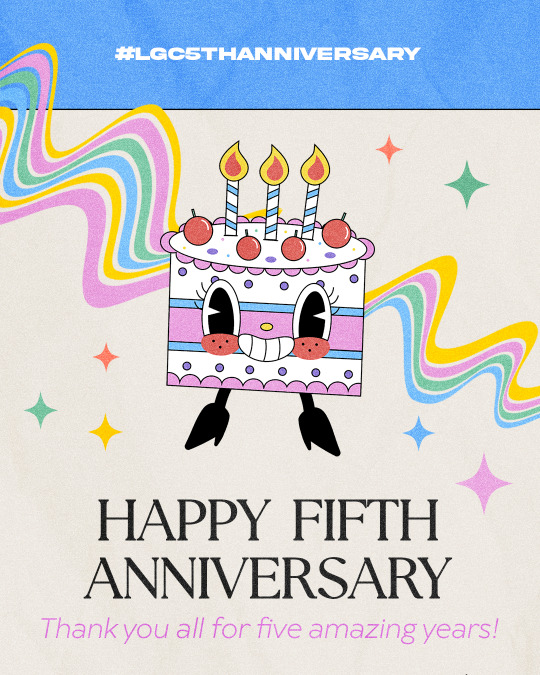
HAPPY FIFTH ANNIVERSARY!
HAPPY FIVE YEARS, EVERYBODY ! ♡ can you believe we're already half a decade old already ? the baby that is lgc is off to kindergarten, and we can't help but cry like proud parents. 😭 in all seriousness though, it feels like just yesterday that lgc opened, and now five years have already passed – and yet, it's as if we're still just getting started. of course, lgc would have never made it this far without its members, and we're all so grateful to still be able to provide a space through lgc for everyone – us included ! – to enjoy ourselves both personally and creatively. as a thank you to all of you –as there's not even enough words in the world to express it enough ! – for everything, we'll be gifting everyone +30 FREE SKILL POINTS to distribute. please submit your LGC 5TH ANNIVERSARY points to the points blog before AUGUST 24, 2024 11:59 EDT. you may use this post as proof for your points sheets. additionally, we've created a simple GRAPHIC TEMPLATE for the UNIVERSE platform to use on our FANSITES. moving forward, this template will be linked in the monthly sns updates. we also don't want to discourage anyone from creating their own graphics for the fansites, especially like some have been for the monthly universe prompt. there used to be a non-canon twitter account that acted as a fan translation account for lgc artists on bubble. while fun and enjoyable, it was confusing whether or not what was posted on that account was considered canon in lgc, so we wanted to OFFICIALLY create a way for members with debuted muses to send messages on universe. we also hope this encourages members to post on the fansites more than twice a month. we've put together a EXAMPLE on how the universe graphics can be utilized with tumblr's text editor. please keep in mind that your posts must be company-appropriate and that the usual rules for sns still apply. we also ask that you refrain from interacting with or commenting on other lgc artists' activities through universe. additionally, idols may only post with their group mates. make sure to tag your fansite posts with #lgc:universe, and let us know if you have any questions. ( if you don't have access to photoshop or other editing software, please message us ! a member of the admod team can create/update your muse's universe profile for you, and will upload the final images to the same drive folder where the templates can be found. ) we still have more cool and really exciting things ( as you might've already seen on the LGCMANAGER blog *wink wink* ) planned for our fifth anniversary, but before we get ahead of ourselves, we do want to reiterate yet again how incredibly thankful we are for everyone who's made lgc their home. we cannot stress enough how humbled we are to lead a group of such talented and passionate writers. under the cut, you can read a short letter from some of us to express our gratitude in our own words. but from us as a whole, thank you from the bottom of our hearts for five years. here's to many, many more ! ♡ your lgcadmod team
happy five years, everyone!!! i can't believe it, lgc has officially lasted longer than my high school career, my college career, etc... it's crazy to think that such pivotal moments of my life have happened with lgc always there, in the background, as one of the only constants in my life. i say it every year and i'll say it again, but i can't thank you all enough for making lgc be the home that it is for me. i mean, this is the longest relationship i've ever committed to in my life!! seriously though, i'm so grateful for everyone i've met here and everything i've accomplished here, but we're not done yet! we still have so much in store for you all, and the anniversary event is just the tip of the iceberg of the fun stuff we've got planned this year alone. after all five years is just a drop in the bucket, let's double it and make it ten. 😎
— love yall so much, kristin (admin *)
it felt like yesterday when i was writing a message for lgc’s first anniversary and now that we’re celebrating the fifth one is something that shocks me sometimes! from starting off as a regular member, to a points and press mod, and now an admin that handles an array of tasks, i’ve seen quite a lot and if there’s anything that these anniversaries remind me of, it’s the dedication and commitment that everyone has to building and maintaining this community. i still remember seeing the first batch of muses receiving their 200 notoriety reward and the excitement and anticipation of wondering what that special 200 notoriety reward submit had to…well, 1,000 notoriety rewards happening! as someone who loves seeing the muses’ progression, it brings me joy whenever i see other muses reach certain milestones because not only does it show the dedication the mun has towards their muse, but the development the muse has gone through, just like the rp itself. legacy started off as a new rp but over time, changes and additions were made to make this rp awesome and a lot of that is thanks to everyone’s contributions. your suggestions, reactions, and even written posts, shaped legacy to be the way it is right now and will continue to do so in the future too! i’d also like to give a special shoutout to the past and present admod team members! legacy itself is quite a massive roleplay to take care of, but thank you so much for all of your effort and ideas! it makes me happy reading and seeing some of the projects being worked on behind the scenes from the admods and every time i hope that everyone else enjoys them too! as mentioned above, there are exciting things coming and i’m certain that the rest of 2024 and 2025 will be quite a ride too (trust me, some stuffs for 2025 have been planned since q2)! once again, thank you everyone for being a part of such a special moment and happy 5th anniversary to lgcrp!
— love, cloud ☁️ (admin a)
five years already, it sounds surreal! Although my importance as an admin has become lesser since my return, I can’t help but feel pride that the roleplay has been thriving for such a long time. and that is all thanks to you, the members, as well as the wonderful team of admins and mods that work tirelessly to make LGC function. whether you have recently joined, or even to those who left, everyone who has passed through LGC has left their mark and helped make it the place it is today. when we created the rp, I don’t think any of us expected it to last this long with so many invested and wonderful members. it really warms my heart. let’s cheer to another five years, maybe?
— love, marie
25 notes
·
View notes
Text
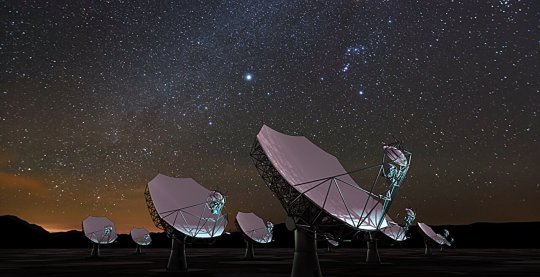
New data model paves way for seamless collaboration among US and international astronomy institutions
Software engineers have been hard at work to establish a common language for a global conversation. The topic—revealing the mysteries of the universe. The U.S. National Science Foundation National Radio Astronomy Observatory (NSF NRAO) has been collaborating with U.S. and international astronomy institutions to establish a new open-source, standardized format for processing radio astronomical data, enabling interoperability between scientific institutions worldwide.
When telescopes are observing the universe, they collect vast amounts of data—for hours, months, even years at a time, depending on what they are studying. Combining data from different telescopes is especially useful to astronomers, to see different parts of the sky, or to observe the targets they are studying in more detail, or at different wavelengths. Each instrument has its own strengths, based on its location and capabilities.
"By setting this international standard, NRAO is taking a leadership role in ensuring that our global partners can efficiently utilize and share astronomical data," said Jan-Willem Steeb, the technical lead of the new data processing program at the NSF NRAO. "This foundational work is crucial as we prepare for the immense data volumes anticipated from projects like the Wideband Sensitivity Upgrade to the Atacama Large Millimeter/submillimeter Array and the Square Kilometer Array Observatory in Australia and South Africa."
By addressing these key aspects, the new data model establishes a foundation for seamless data sharing and processing across various radio telescope platforms, both current and future.
International astronomy institutions collaborating with the NSF NRAO on this process include the Square Kilometer Array Observatory (SKAO), the South African Radio Astronomy Observatory (SARAO), the European Southern Observatory (ESO), the National Astronomical Observatory of Japan (NAOJ), and Joint Institute for Very Long Baseline Interferometry European Research Infrastructure Consortium (JIVE).
The new data model was tested with example datasets from approximately 10 different instruments, including existing telescopes like the Australian Square Kilometer Array Pathfinder and simulated data from proposed future instruments like the NSF NRAO's Next Generation Very Large Array. This broader collaboration ensures the model meets diverse needs across the global astronomy community.
Extensive testing completed throughout this process ensures compatibility and functionality across a wide range of instruments. By addressing these aspects, the new data model establishes a more robust, flexible, and future-proof foundation for data sharing and processing in radio astronomy, significantly improving upon historical models.
"The new model is designed to address the limitations of aging models, in use for over 30 years, and created when computing capabilities were vastly different," adds Jeff Kern, who leads software development for the NSF NRAO.
"The new model updates the data architecture to align with current and future computing needs, and is built to handle the massive data volumes expected from next-generation instruments. It will be scalable, which ensures the model can cope with the exponential growth in data from future developments in radio telescopes."
As part of this initiative, the NSF NRAO plans to release additional materials, including guides for various instruments and example datasets from multiple international partners.
"The new data model is completely open-source and integrated into the Python ecosystem, making it easily accessible and usable by the broader scientific community," explains Steeb. "Our project promotes accessibility and ease of use, which we hope will encourage widespread adoption and ongoing development."
7 notes
·
View notes
Note
Out of curiosity (and of course please do not feel like you have to answer this)
How do you keep your story organized?
I use Miro Board to help me lay down my plot and timelines, but I’m always curious what other tools writers use to outline, organize and such for their writing.
Id love to also just create a post and have writers and artists add to it over time as a source of knowledge and help….but I’m not sure how to start it honestly.
i love this questions and for me it's SCRIVENER, baby, SCRIVENER

i'm using OCCULT PIECE as an example because it's a massive project and Scrivener absolutely helped me bring it to life (it finally corralled my brain into something manageable LMAO)
not sure how familiar you are with this software, but it combines a word processor with a file organization system so i can flip between documents within a work super quickly...keeps all my notes, drafts, and other docs at my fingertips
the column on the left shows the docs and folders i've set up to keep this massive AU project organized...i have folders for each story, with subfolders that have notes and chapters for each work, and then i have separate folders for worldbuilding notes, character notes, connections between stories, and similar...i expanded a bunch of the folders so you can see what's in 'em if you want a closer look
Scrivener also has a corkboard view so you can see your story elements all laid out, and you can move them around as you see fit, which makes rearranging scenes (should you choose to put separate scenes into their own text docs) very easy
i like this software for its utility but also because you pay for it once and then can transfer the license to different computers when/if you change to a new one, and you can get it pretty cheap using discount codes that come up pretty frequently (usually they're a NaNoWriMo prize)
i have never used Miro and IDK how it compares! will have to check it out and seeeeee
as for the post people can add to, do you mean like a Tumblr post with reblogs, or like a shareable document people can circulate and add to at will? would this be for a large collaborative story or universe or just general information? sounds cool either way! love it when a community comes together...
20 notes
·
View notes
Text
All right, since I bombarded a poor mutual yesterday...
Privacy is not security and security is not privacy. These terms are not interchangeable, but they are intrinsically linked.
While we're at this, anonymity =/= security either. For example, Tor provides the former, but not necessarily the latter, hence using Https is always essential.
It is impossible to have privacy without security, but you can have security without privacy.
A case in point is administrators being able to view any data they want due to their full-access rights to a system. That being said, there are ethics and policies that usually prevent such behavior.
Some general tips:
Operating System: Switch to Linux. Ubuntu and Linux Mint are widely used for a reason. Fedora too. And don't worry! You can keep your current operating system, apps and data. If you're on a Mac computer, you can easily partition your hard drive or SSD by using Disk Utility. If you're on Windows, you can follow this guide.
You want to go a step further? Go with Whonix or Tails. They're Linux distributions as well, but they're both aiming for security, not beauty so the interface might not be ideal for everyone. Many political activists and journalists use them.
You want anonymity? Then you need to familiarize yourself with Tor. Also, Tor and HTTPS and Tor’s weaknesses. When you're using it, don't log in to sites like Google, Facebook, Twitter etc. and make sure to stay away from Java and Javascript, because those things make you traceable.
Alternatives for dealing with censorship? i2p and Freenet.
Is ^ too much? Welp. All right. Let's see. The first step is to degoogle.
Switch to a user-friendly browser like Firefox (or better yet LibreWolf), Brave or Vivaldi. There are plenty of hardened browsers, but they can be overwhelming for a beginner.
Get an ad blocker like Ublock Origin.
Search Engine? StartPage or Duckduckgo. SearXNG too. Like I said degoogle.
Get a PGP encrypted e-mail. Check Protonmail out.
There's also Tutamail that doesn't cover PGP, but uses hybrid encryption that avoids some of the cons of PGP.
Skiff mail is also a decent option.
Use an e-mail aliasing service such as SimpleLogin or AnonAddy.
Check OpenPGP out. Claws Mail is a good e-mail client for Windows and Linux, Thunderbird for Mac OS.
Gpg4win is free and easy to use for anyone that wants to encrypt/decrypt e-mails.
Instead of Whatsapp, Facebook messenger, Telegram etc. use Signal for your encrypted insant messaging, voice and video calls.
Get a metadata cleaner.
Get a firewall like Opensnitch, Portmaster or Netguard which can block Internet for trackers.
Alternatively, go with a private DNS that blocks these trackers. NextDNS is a good paid service. Rethink a good free option.
Replace as many of your applications as you can with FOSS (free and open source) ones. Alternativeto can help you.
Always have automatic updates on. They are annoying af, I know, but they are necessary.
Keep your distance from outdated software.
Always have two-factor authentication (2FA) enabled.
Do not use your administrator account for casual stuff. If you're on Linux, you probably know you can be sudo, but not root.
On Linux distributions use AppArmor, but stay away from random antivirus scanners. Other distributions default to SELinux, which is less suited to a beginner.
Never repeat your passwords. If you can't remember them all, use a password manager like KeePass.
Encrypt your drive.
Honestly, VPNs have their uses and ProtonVPN, Mullvad and Windscribe are decent, but eh. If you don't trust your ISP, why would you trust the VPN provider that claims they don't log you when you can't verify such a thing?
52 notes
·
View notes
Note
Let me preface this: I'm an architecture major
I used to be a big LO fan but obviously fell out of love of it like a lot of us did, and I know LO uses SketchUp for backgrounds. That is not an issue I have with the comic or any comic, I want artists to have an easier time in any way they can. I was always under the impression Rachel imported the models into Photoshop and drew over them like you can see in the early episodes with the sketchy lines. Well, school just started recently for me and I now have access to SketchUp for my coursework, and I made a few discoveries: 1. Photoshop cannot read SketchUp files, and while you can import them into Clip Studio through some configuring, they can be finicky and will lose parts in the importing process, so they are best used into the original SketchUp program to export as PNGs. 2. Many of the models Rachel uses are incredibly easy to find, especially if you put "modern", "luxury", or "classy" before the main part of the search. Many of the houses and rooms for example are first page results. 3. The biggest discovery: You know how we all assumed Rachel was hand-drawing all the lines over the SketchUp models and how she gave up the longer LO went on? Well, it's actually worse. It turns out SketchUp has a thing called "Styles" in it, which means you can mess with the lines and look of the model, such as making it look more like a blueprint or playing with the colors. Well, they have a lot of styles on SketchUp known as "sketchy lines", which are the exact ones Rachel used early in the comic to fit with her style, and it takes a literal click of a button to do. All she would do is pose the model, click the sketchy line style, and export the PNG. That's it. So, yeah, Rachel is so checked out of the comic that she can't even bother to click a single button to make the models fit into the comic's style anymore. Use that information however you like.
Ouhhh sorry OP, I'm about to like, undo all the work you just put into that ask. We've already known about the 3D background problem for a long while now.
First off, it's more likely LO doesn't use SketchUp but actually Acon3D, which is a website that offers 3D models both for free and at cost, which are actually compatible with software like Clip Studio. As soon as you open it up you'll likely see a lot of very familiar backgrounds that are often used in romances, isekais, and period pieces. It's literally the go-to spot for Webtoon Originals creators. Like, to the point that I wouldn't be surprised if Naver was partnered with them because of how many of their creators use it.
Second, there's plenty of up-to-date evidence to support the fact that Rachel doesn't exclusively stick to one software, sometimes she's drawing in Photoshop, sometimes she's drawing in Clip Studio Paint, sometimes she's drawing in Procreate. She's undoubtedly using Clip Studio for her paneling, speech bubbles, and backgrounds, as there are built in tools to utilize and convert 3D materials into lineart, among other features that are recognizable as coming from CSP because they're not available in PS or Procreate.
Third, yes, she just uses filters to turn her backgrounds into lineart, this has been apparent since S1. The only backgrounds she's ever 'hand drawn' were the ones involving lots of nature and even those are mostly just Photoshop brushes stamped on.
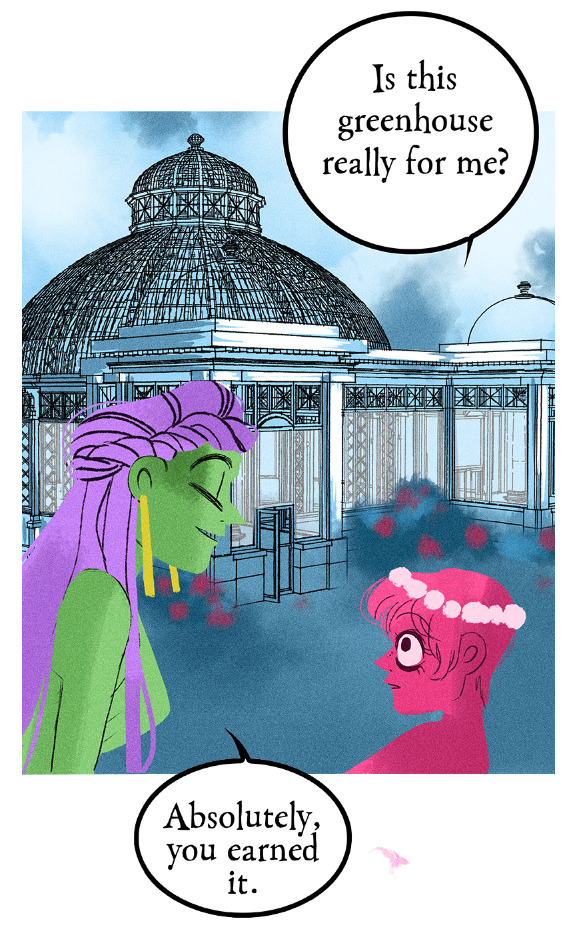
Like I realize I'm probably bursting your bubble here and I apologize for that lmao but these buildings were never hand-drawn, this is not new information ( ̄﹏ ̄;) I appreciate you mentioning your own experiences with it as you're learning it though, I find once you start to learn the process yourself you really start to notice what others are doing. Even I've gone through that over the past couple years as I started to use 3D models and more advanced tools specifically for drawing webtoons.
I will mention btw, there's nothing wrong with using 3D models for your character drawing and backgrounds. The only time it tends to get frustrating is when you're reading a comic that isn't making any attempts to blend the background in with the art style.
Like, The Kiss Bet probably uses 3D models to help with perspective and laying out scenes quickly without second-guessing, but you can tell they still hand-draw over the models because they look natural and like they belong to the comic's stylization. The characters don't look out of place sitting in a living room and the living room doesn't look distracting.
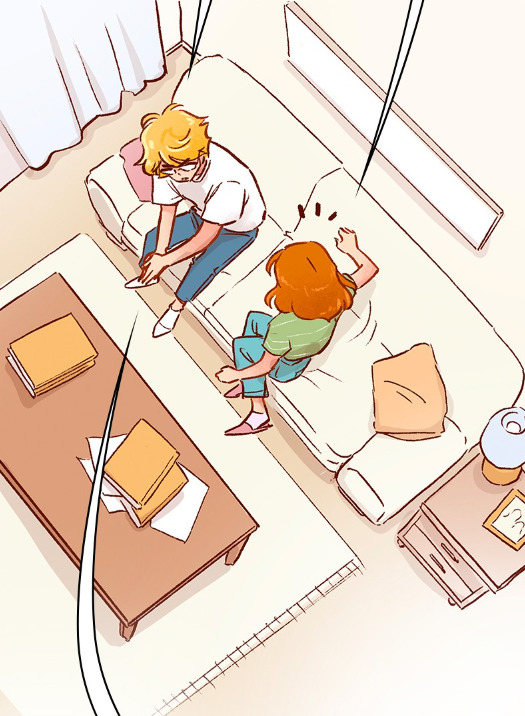
But then you get stuff like Lore Olympus, Let's Play, and Midnight Poppy Land, and it becomes a bit more obvious they're not giving a shit about backgrounds lmao


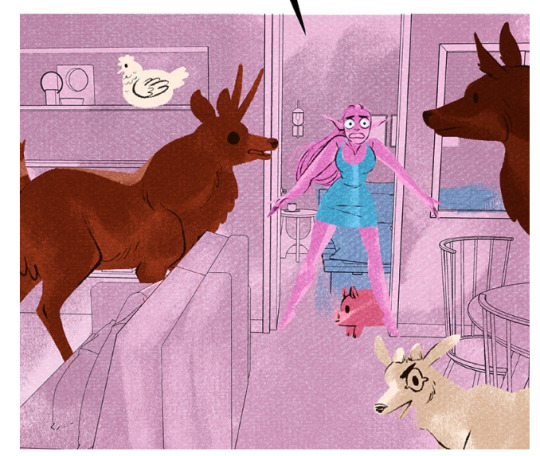
I get it, WT's deadlines are cutthroat as fuck, but if it's getting to the point that you have an entire team behind you and you're literally just copy pasting video game models from Phantom Hourglass, then it's probably time to re-focus your priorities a bit. There are comics with as few as 1-2 assistants (and even in some cases no assistants at all!!) pulling off backgrounds better than this, even when they're taking shortcuts.
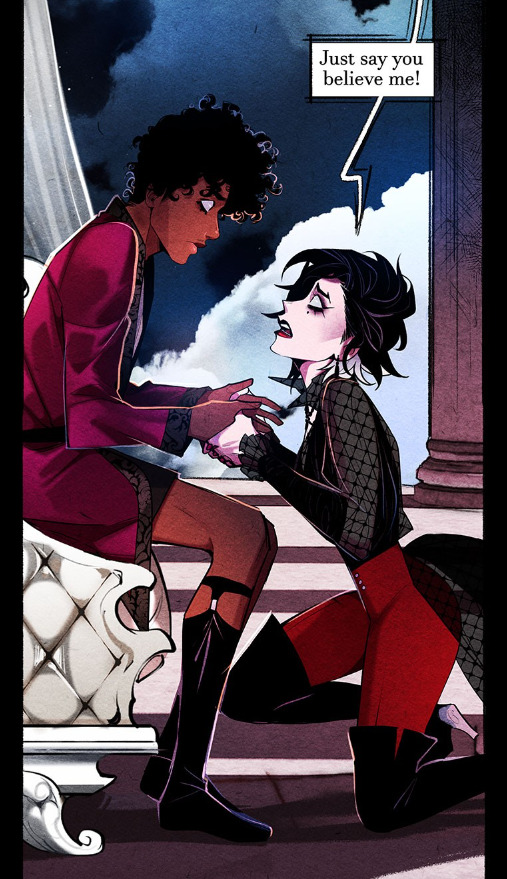

(Nevermore and City of Blank)
But a lot of that does come down to how WT manages its expectations as well as support for their creators. The deadlines and requirements WT puts their creators under are insane and awful in the long-term, and they're not acting with the amount of professionalism they ought to be for a platform that's trying to breakout as a major publisher here in the West. I feel like it comes down to WT loosening the choke chain around their creators, but also creating a standardized level of quality to ensure it's not suffering for the sake of quantity. The traditional literature industry has real editors and stages of quality control for a reason, whereas WT is more interested in just throwing as many series at the wall and dumping all their stock into the ones that stick.
#lore olympus critical#lo critical#webtoons critical#antiloreolympus#anti lore olympus#ama#ask me anything#anon ama#anon ask me anything
89 notes
·
View notes
Text
Yvette Heiser - Mastering Night-time Food Photography in the Heart of Texas
Texas is renowned for its vibrant food scene, from sizzling BBQ and Tex-Mex delicacies to gourmet farm-to-table experiences. As the sun sets and the city lights twinkle, capturing the essence of nighttime dining becomes an art form of its own. Discover Photography in Texas with Yvette Heiser, as mastering night-time food photography allows you to showcase the delicious offerings and unique ambiance of Texas restaurants and street food vendors. In this article, we will explore practical tips and techniques to elevate your nighttime food photography, making your images as mouthwatering as the dishes themselves.

Understanding the Importance of Lighting
Lighting serves as the foundation of any outstanding photograph, particularly in the realm of food photography. At night, natural light is scarce, so you’ll need to rely on artificial lighting sources to bring your images to life. Here are several important factors to keep in mind:
- Use Soft Light: Harsh, direct lighting can create unflattering shadows. Instead, opt for soft light sources such as table lamps, candles, or string lights. Position these lights strategically around your food to create a warm, inviting atmosphere.
- Experiment with Exposure Settings: When photographing at night, you may need to adjust your camera’s exposure settings. A longer exposure time can help capture more light, but be cautious of motion blur. Use a tripod to keep your camera steady, allowing for sharper images even in low light.
Choosing the Right Angles
The angle from which you photograph your food can dramatically change the viewer's perception. Here are some angles to consider when capturing nighttime food scenes:
- Top-Down Shots: This angle works well for flat dishes, such as pizzas or tapas. It allows you to capture multiple items and showcase the table's overall aesthetic. Enhance this shot by including utensils, drinks, and other elements that create a lively dining atmosphere.
- 45-Degree Angles: This angle strikes a balance between a top-down and side shot, offering depth and dimension to your images. It’s ideal for dishes served in bowls or with layers, allowing viewers to see both the surface and the interior of the food.
- Close-Ups: Don’t hesitate to get up close and personal with your food. Close-up shots can highlight textures and intricate details that make dishes appealing. A close-up of a juicy steak or a decadent dessert can leave viewers craving more.
Utilizing Props and Backgrounds
The right props and backgrounds can elevate your food photography. Here are a few suggestions to elevate your nighttime food photography:
- Textured Surfaces: Use wooden tables, rustic cutting boards, or slate plates to create a contrasting background. The texture can add depth to your images and make the food stand out.
- Include Contextual Elements: Incorporate elements that represent the Texas culture, such as vintage cowboy hats, mason jars, or fresh herbs. These items can tell a story and enhance the narrative of your food photography.
- Play with Colors: The warm tones of Texas cuisine can be beautifully complemented by contrasting backgrounds. For example, vibrant dishes can pop against darker surfaces, while cooler dishes may benefit from warmer, earthy tones.
Post-Processing Techniques
Editing is a crucial step in food photography that can help enhance the overall aesthetic of your images. Consider the following techniques:
- Adjust Brightness and Contrast: Increase brightness slightly to compensate for low-light conditions and enhance the contrast to make the colors pop.
- Enhance Colors: Use editing software to boost the saturation and vibrancy of the food without overdoing it. The aim is to present the food in a way that reflects its delicious flavor.
- Sharpen Details: Use the sharpening tool to highlight textures, making the food look even more appetizing.
Conclusion
Mastering night-time food photography in the heart of Texas allows you to showcase the unique flavors and ambiance of this vibrant state. By understanding the importance of lighting, choosing the right angles, incorporating props, and employing effective post-processing techniques, you can create stunning images that capture the essence of Texas cuisine. As outlined in Yvette Heiser: Deliciously Dark Guide to Night-time Food Photography, these elements are crucial for achieving captivating results. So grab your camera, head out into the lively Texas night, and start capturing those delicious moments!
#camera#wedding#moments#photographer#pictures#childphotography#yvette heiser#photography#photographytips#events
7 notes
·
View notes
Text
Occultist implements: Pop culture Cybermancy Magic
In pathfinder the concept of an occultist is the use of implements or tools to invoke the powers of other magic types. Similar to a warlock in my opinion or a wizard. In this post I wanted to list the tools that I see as comparable to the pathfinder occultist class. This falls into my Otherworld channeling class as a form of glamour but also as a form of shapeshifting. Not all implements are going to be technological, but they will work well in cybermancy when applied correctly.
Here is the page I used to draw up this list: https://www.d20pfsrd.com/alternative-rule-systems/occult-adventures/occult-classes/occultist/occultist-implements/
Abjuration
For abjuration, I could see myself using an amulet in the game or a holy symbol. Cybermancy versions of this would be as follows: A usb drive as a necklace with images in it as a form of statuary images, an actual amulet with a holy symbol (a pentagram or a triquetra).
Conjuration
For conjuration I feel that a figurine would be a good match for me. Examples of this would be images of trading cards from a game or my pokemon go+. Alternatively, a compact mirror would be a good physical tool as well.
Divination
Given that divination is my specialty in magic, I find that I have a lot of divination tools. My main ones that I have from this list are books, tarot decks (harrow decks) and crystal balls. I have the physical and the digital. Cybermancy versions of books and decks are my favorite go to for on the go.
Enchantment
This one should be pretty easy to guess. Enchantment being about the mind and emotions, anything to do with auditory senses is gonna be a tool for enchantment. In terms of software I use Audible, various music apps and YouTube. In terms of tech, a good set of noise canceling headphones or Dj headphones is ideal (preferably Bluetooth and foldable). Alternatively, you could use any retro tech like a cassette player, a cd player, or an mp3 player. Bonus points if the cd or cassette player has mp3, am/fm radio, and the ability to play cds or cassettes respectively.
Evocation
Ok while not necessarily tech based, metal of any kind is a good conduit for cybermancy. The implement that I would choose in this category would be a wand. A collapsible metal pointer or an old collapsible radio antenna is a great aesthetic and works well for commanding cybermantic energies. Alternatively an app like the Dr. who sonic screwdriver app is a good one for those that want their implements to be virtual.
Illusion
I’m gonna go with a crystal from this list because images of crystals are just as strong as their real counterparts. Also crystals resonate well with electrical energies.
Necromancy
While necromancy isn’t a specialty or even something I’ve extensively studied, I would have to go with the coins. Let’s be honest, we all have loose pennies that we have no real use for. So turn them into necromancy conduits. Copper may be a metal not associated with earth but it is useful for calling the dead because copper is a conduit through which the two worlds can be bridged.
Transmutation
I’m gonna have to go with belt for this one because a belt can also hold a bag on which your tools go. Thus it’s like Batman’s utility belt.
Update:
After thinking about it a bit, here is a condensed list of tools:
Abjuration: usb and divine images
Conjuration: Pokémon go +, digital trading card collection
Divination: tarot apps, astrology apps, e-book apps, zen water apps, dice apps, video apps
Enchantment: Bluetooth speaker or headphones for crowd control respectively and music playlists
Evocation: stylus as wand
Illusion: Crystal of choice or images that create glamours
Necromancy: keyboard as spirit board, automatic writing, camera app for seeing the spirits, audio recorder for spirit box
Transmutation: computer games for in game energy transmutation and digital charm bags. Music playlists as potions for transmutation.
#witchblr#witchcraft#magick#grimoire#tech witchcraft#divination#theory#writing magick#pop culture magick
5 notes
·
View notes
Note
I've seen you posting about what I think is a DnD campaign, and I'm wondering what software the screenshots are from?
It is a DnD campaign, even if an odd one!!
We use FoundryVTT, which is an absolute godsend. It's a Virtual TableTop (like roll20), with a few differences:
It's single payment. $50, but it goes on sale, and it's very lenient with the license (one person gets it, the whole group can use it to DM as they'd wish! they don't really care)
No subscriptions or extra payments after that. You get the entire software with all of its utilities for that.
It's self-hosted (think like Minecraft servers) but it's easy to set up and it's wonderful since you don't need to worry about storage
It comes with just all sort of functionalities out of the box and it's far much more fleshed out than roll20. There's a lot of integrated TTRPG systems in it already (including 5e, Pf2e, Blades in the Dark, Call of Cthulhu, etc), which update constantly
The software itself is also actively updated and they add more functionalities constantly- It's already VERY good, but they keep expanding it!
A very important one, but it allows modding and has a very active modding community, so if there's a functionality the base software doesn't have, chances are that someone already did it. for example, the healthbar or the turn markers are mods
Honestly the devs are pretty cool too and I appreciate the work they do
For some of the cool functionalities it has that I really use (most of which roll20 doesn't have)
It's just really well optimized and they actively work on optimizing it further with every update!
This one is very important to me, but it allows animations natively, which I use quite a bit for animated tokens. There's people who have done animated spell effects and such too. It supports webm, which are much better than gifs
Overall a LOT of visual customization. You can set lights in the scene with lots of animation, filters, there's a mod to add weather and particle effects, you can have forehead tiles (basically stuff that is over the character), etc.
The sheet and inventory management system is so much better than roll20! you can drag and drop features, classes, spells, all that sort of stuff. Pf2e's module is particularly well done and you can just drag about everything and get a sheet ready in no time
it has a delightful vision system with integrated walls, fog of war and so on (yknow, that thing that roll20 has behind a paywall, but better)
integrated rulers and templates too!
and of course just endless customization with mods
a really nice system for journals, player notes, handouts, etc
fairly specific but you can make both lootable chests and interactive shops for your players with a mod and I LOVE that
I could fawn ALL day about how much I love this software. I ran my campaign in roll20 for two years and the amount of wrestling I had to do with it was infuriating! I really recommend FVTT to pretty much anyone. It can be a bit overwhelming at first since it's a bit harder (given how much functionality it has), but once you get used to it, it's hard to go back to other stuff tbh
18 notes
·
View notes